On July 24, 2024, India’s Defense Research and Development Organizations (DRDO) conducted its Phase-II Ballistic Missile Defense (BMD) flight test. The official press release claimed that the successful test of the two-stage solid fuel AD endo-atmospheric missile interceptor bequeathed India with the capability to neutralize 5,000 km range ballistic missiles in the “endo to low exo-atmospheric” altitude bracket. This was the second test of India’s land-based Phase-II BMD and followed the maiden flight trial of the sea-based endo-atmospheric interceptor in April 2023.
India launched the BMD pursuit in the late 1990s and conducted the maiden test of its interceptor missile in December 2006. India’s planned “multi-layered” BMD system is to be completed in two phases: Phase-I consists of high-altitude Prithvi Air Defense (PAD) and low-altitude Advanced Air Defense (AAD) and is designed to defend against missiles falling within a 2,000 km range; Phase-II BMD comprising of AD interceptors would on paper equip India with the capability to neutralize 5,000 km range missiles.

In 2020, Indian media reports citing defense sources claimed that the tests for India’s Phase-I BMD have been completed and the system awaits the government’s nod for deployment to defend the capital New Delhi. Recently, Indian media reports claimed that India’s Phase-I BMD has been deployed without divulging further details.
Most of the Indian accounts cite ballistic missile threats from China and Pakistan as the driving factor behind India’s BMD development and also allude to India’s declaratory No First Use (NFU) nuclear employment policy to rationalize India’s BMD pursuit. However, statements from the top Indian leadership following the BMD tests suggest that international prestige remains the primary driving factor behind India’s pursuit of BMD.
At first glance, BMDs appear defensive: military systems defending against missile threats. However, a detailed view of the BMDs’ characteristics accentuates the intrinsic capabilities of the systems contributing to undermining strategic stability by aggravating crisis instability and arms race instability.
BMD systems aim to minimize the magnitude of the enemy’s retaliation thus undermining the state of mutual vulnerability, which has been the cardinal principle of deterrence since the onset of the nuclear age. Despite their limited success rate, deploying BMD systems complemented by other counterforce capabilities creates strong incentives for damage-limitation counterforce strikes, ultimately leading to the highest degree of crisis instability. To ward off counterforce threats and given that the most feasible approach to counteract BMDs is overwhelming them through enhanced numbers, the adversary’s warhead tally undergoes an upsurge thus sparking the risk of arms race instability.
At present, India’s BMD capabilities are relatively modest and it would be several years or even decades before New Delhi could deploy its multilayered BMD. The Indian media reports — indirectly owned by DRDO — claim that once operational and integrated, India’s BMD would have a success rate of 99.8%. It is worth underscoring that the USA’s Missile Defense Agency (MDA) after investing more than $200 billion since 1985 in the BMD program claims 81.9% successful hit-to-kill intercept attempts from 2001 – 2018 across all of its programs during optimal testing conditions. Keeping in view the cutting-edge quintessence of the USA’s technological base and backed by huge investments in the BMD, Indian claims of a prospective 99.8% success rate do not appear to be anything but self-deceiving pretense aimed at bestowing the political leadership with delusionary complacency of defense against the adversaries’ ballistic missiles.
Given that the Indian leadership has essentially shrugged off the core tenets of the theory of nuclear revolution by long aiming to find space to use force under the nuclear overhang, the delusion of defense provided by BMD could further incentivize New Delhi to tilt more towards resorting to nuclear brinkmanship and to act more recklessly during a crisis. Supplement this risk-prone attitude of Indian leadership with India’s counterforce temptations towards Pakistan backed by its relentless pursuit of other counterforce technologies, such as MIRVs and improved ISR, the consequence would be the highest degree of crisis instability in South Asia.
India’s 2003 declaratory nuclear doctrine relies on the threat of “massive” retaliation “to inflict unacceptable damage”, which falls within the “deterrence-by-punishment” model. The BMD pursuit entails India’s nuclear force posture tilting more towards “deterrence-by-denial”. Keeping in view India’s counterforce ambitions vis-à-vis Pakistan in contravention of its declaratory policy of NFU, India’s leaning toward “deterrence-by-denial” with the pursuit of BMD further underscores inconsistencies in India’s declaratory nuclear doctrine and the emerging force posture. This would further undercut the transparency in the deterrence equation between Pakistan and India thus undermining strategic stability in South Asia.
Keeping in view the imminent integration of MIRV technology in Indian missiles, India’s nuclear arsenal (which surpassed Pakistan’s estimated arsenal as per the 2024 SIPRI report) is likely to undergo a manifold increase. India’s attempts to gain a strategic advantage through its relentless drive to bolster the nuclear triad, imminent massive-scale increase in its nuclear arsenal, and its unrelenting pursuit of BMD imperil the delicate strategic equilibrium in the region thus risking arms race instability.
Pakistan has long held that it shoulders the responsibility of maintaining strategic stability in South Asia by counteracting India’s attempts to pursue a strategic advantage, which undermines strategic stability in the region. Given its limited resources, Pakistan is unlikely to enter into an arms race with India i.e. mirroring India’s weapon developments. However, Islamabad has been recalibrating its nuclear doctrine and force posture under the policy of Full Spectrum Deterrence (FSD) within the precincts of Credible Minimum Deterrence (CMD) to effectively deal with the ever-changing threat landscape.
Keeping in view India’s BMD ambitions, in 2017, Pakistan carried out the maiden flight test of its MIRVed surface-to-surface ballistic missile Ababeel with a maximum range of 2,200 kilometers. The second flight test of the missile was carried out in October 2023 and the missile was displayed during the 2024 Pakistan Day military parade. Once operational, Ababeel would provide Pakistan with adequate penetration capability to overcome India’s BMD. However, given that the MIRVs carry multiple warheads, they also can be alluring counterforce targets, which makes it an inevitable compulsion for Pakistan to double down on its efforts to enhance the survivability of its arsenal, especially the MIRVed missiles. Survivable MIRVed missiles would check Indian leadership’s delusionary expectation of defense through BMD and would act as Pakistan’s checkmate to Indian attempts to create strategic imbalance through BMD.























